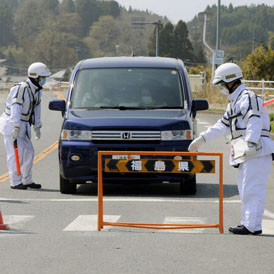Japan bans people from entering Fukushima evacuation zone
Japan has banned people from entering a 12 mile evacuation zone around the Fukushima nuclear plant following the tsunami. People will now only be able to go there under Government supervision.

Tens of thousands of people left the zone after Japan’s earthquake and tsunami but some have since returned to their homes to collect belongings.
The disaster badly damaged cooling reactors at the Fukushima plant leading to radiation leaks.
The Japanese Government has said it will take legal action against people who flout the new law and enter the evacuation zone.
Chief Cabinet Secretary Yukio Edano told a press briefing that as of midnight on Thursday, people will only be allowed into the area under Government supervision.
“The setting of the no-entry zone and (last month’s) evacuation instruction are aimed at securing the safety of the people,” Edano said.
“For residents, all I can say is I ask for their understanding so that no legal action will be taken against them.”
Channel 4 News special report: Japan quake - tsunami to nuclear crisis
A continuing crisis
TEPCO, the Fukushima plant’s operators, has said it may take the rest of the year or longer to bring the plant under control.
This week it began pumping highly contaminated water from one of the reactors, a key step towards repairing the cooling system that regulates the temperature of radioactive fuel rods.
But water levels were unchanged, the latest in a litany of problems engineers have faced since the crisis began, which has included pumping radioactive water into the sea, to the concern of Japan’s neighbours.
French nuclear plant maker Areva will supply a water treatment plant that uses a process called “co-precipitation” – which isolates and removes radioactive elements from water – to speed up decontamination of the Fukushima site.
Read more: How dangerous are blasts at nuclear plants?
TEPCO hopes to begin the water treatment before the end of May, Areva’s chief executive Anne Lauvergeon said in Tokyo this week.
TEPCO insists that while fuel rods at three of its six reactors were damaged when they partially melted after the quake, they are not in “meltdown”.
Japan’s Prime Minister Naoto Kan, under fire from the opposition and even within his own Democratic Party of Japan (DPJ) over his handling of Japan’s worst crisis since World War Two, was visiting Fukushima on Thursday.
More than 13,000 people were killed and tens of thousands lost their homes when the 9.0 earthquake and 15-metre tsunami hit Japan’s northeastern coast.
More than 130,000 people were in shelters at the start of this week, according to police figures.
-
Latest news
-
Windrush scandal: returning to the UK after a forty year wait6m

-
Netanyahu ‘survival’ depends on ‘expanding war’ says head of Palestinian National Initiative5m

-
Proposed law change could strip parental rights from paedophiles5m

-
Hugh Grant settles privacy lawsuit against The Sun newspaper publisher2m

-
Post Office Scandal: what did top executive know?6m

-




